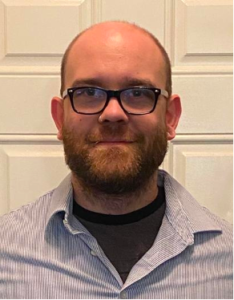 |
Dr. Eric W. Welch |
| Title: Assistant Professor Phone: (936) 261-3143 Fax: (936) 261-3149 Email: ewwelch@pvamu.edu Office Location: O’Banion 330M Curriculum Vitae: Dr. Welch |
Education:
Ph.D. in Physics, Texas State University, San Marcos, TX 2019
M.S. Physics, Texas State University, San Marcos, TX 2016
B.S. Physics, Texas State University, San Marcos, TX 2014
Biography
Dr. Welch began their scientific career in 2012 after finishing a degree in criminal justice with the intent to go to law school. After learning that one could be a scientist, Dr. Welch started their degrees over and began their path towards a STEM PhD. During their time at Texas State University during their PhD, Dr. Welch was a visiting researcher at the T1 theoretical division at Los Alamos National Lab resulting in a highly cited publication with the computational modeling group and the Center for Integrated Nanotechnology. Dr. Welch is married and has no children but does have furry children in the form of two cats. Dr. Welch enjoys playing dungeons and dragons, magic the gathering, tabletop board games, and enjoys watching football (you all call it soccer), basketball, and hockey.
Research Interests
Dr. Welch uses density functional theory methods to computationally model semiconductor materials for optoelectronic applications. Using high power computing facilities, Dr. Welch’s research focuses on modeling the photophysical properties of perovskites and wide band gap oxides, specifically focusing on defect modeling in these materials. Python coding is used extensively to pre- and post-process data. Dr. Welch is also working to implement machine learning into the workflow of their work.
Social media
https://scholar.google.com/citations?user=PA_hd0AAAAAJ&hl=en
https://www.researchgate.net/profile/Eric-Welch
https://www.linkedin.com/in/eric-welch31415/
Work History
Assistant Professor Prairie View A&M University 2022 – current
Postdoctoral Researcher Texas State University 2019 – 2022
Phd Student/Research Assistant Texas State University 2016 – 2019
MS Student/Research Assistant Texas State University 2014 2016
Awards and Honors
Top Dissertation in STEM Texas State University 2019
Memberships
American Physical Society APS
Materials Research Society MRS
Teaching Interests
Courses Taught
PHYS 2326 University Physics 2 2023 – 2024
PHYS 2325 University Physics 1 2022 – 2023
PHYS 1326 General Physics 2 2023
PHYS 1315 University Physics 1 Lab 2022 – 2023
PHYS 3310 Mechanics
Teaching Schedule: Fall 2025
|
Section
|
Days
|
Room
|
Time
|
| PHYS 4302-P01 – Intro Quantum Mech I | MWF | NSCI 323 | 11:00-11:50 am |
| PHYS 3318-P01 – Modern Physics I | MWF | NSCI 323 | 12:00-12:50 pm |
| PHYS 3312-P01 – Electricity & Magnetism I | TR | NSCI 323 | 11:00 am-12:20 pm |
Teaching Schedule: Spring 2025
|
Section
|
Days
|
Room
|
Time
|
| PHYS 2326-P05 – University Physics II | MWF | NSCI 303 | 12:00-12:50 pm |
| PHYS 2326-P04 – University Physics II | TR | NSCI 330AH | 3:30-4:50 pm |
| PHYS 3316-P01 – Math Physics I | MWF | NSCI 307 | 1:00-1:50 pm |
Teaching Schedule: Fall 2024
|
Section
|
Days
|
Room
|
Time
|
| PHYS 2326-P05 – University Physics II | MWF | NSCI A104 | 12:00-12:50 pm |
| PHYS 2326-P03 – University Physics II | TR | NSCI 301 | 12:30-1:50 pm |
| PHYS 2326-P04 – University Physics II | TR | NSCI 309 | 3:30-4:50 pm |
Research
Research Projects
- Modeling intrinsic defects in perovskites
This is the current dominant project in Dr. Welch’s lab. The most common inorganic perovskites are being used as a model testbed for a new defect modeling methodology. Density functional theory modeling is done in a Python driven workflow to compare this method to currently published literature.
- Modeling doping in wide-band gap oxides
Wide band gap oxide research is a consistently growing field and Dr. Welch has published on doping in the promising next generation optoelectronic device material gallium oxide. Specifically, Dr. Welch wants to see the trends of doping with rare earth metals in gallium oxide and the effects of f-orbital electrons on photophysical properties.
- Machine learning and material science
The newest addition to scientific research, machine learning is becoming a powerhouse in material discovery and high throughput computation.
Journal Articles
- Computational study and ion diffusion analyses of native defects and indium alloying in β-Ga2O3 structures https://doi.org/10.1116/6.0003435
- Indium defect complexes in (In x Ga1− x) 2O3: a combined experimental and hybrid density functional theory study https://doi.org/10.1088/1361-6463/ad1b9b
- Opto-electronic properties of carbon doped NiO https://doi.org/10.1016/j.jpcs.2022.111110
- A density functional theory study on the interface stability between CsPbBr3 and CuI https://doi.org/10.1063/5.0018925
- Polarons in halide perovskites: a perspective https://doi.org/10.1021/acs.jpclett.0c00018
